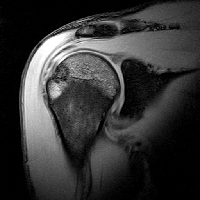Consulting with a sports medicine physician and radiologist at the first sign of abnormal shoulder pain or discomfort may help baseball pitchers and other athletes avoid or delay surgery. Typical problems for baseball pitchers include tendentious, rotator cuff abnormalities, bone spurs and cartilage tears. Tennis players, mountain climbers, rowers, football quarterbacks, Jai Lai players and others who use repeated over-arm motion may also benefit from MR (MRI) of the shoulder.

MR image of the right shoulder
A recent study of fourteen Toronto Blue Jays minor league pitchers was conducted. Tendinitis was found in 23 of the 28 shoulders. Physicians and radiologists propose that there is no difference in the condition of the pitching shoulder versus the non-pitching shoulder since pitchers and other athletes do a lot of symmetrical training, such as weight lifting, using both arms.
Almost all pitchers have pain for at least a day after pitching. This is often the result of repeated over-arm throwing motion. Players with pain that lasts longer than 24 hours should report the condition to their physician. MR can be used to asses the problem in most cases.
MR imaging can detect the beginning of bone spurs, and athletes can do specific exercise and warm ups to prevent progression of the problem. Bone spurs which are allowed to progress must be shaved off surgically. Injuries to the rotator cuff tendon range from inflammation to tears. If the tendon is torn, it must be treated surgically. However, chronic inflammation, which can lead to a tear, can be detected using MR imaging, and the pitcher or other athlete can rest to avoid aggravating the problem.
Many pitchers and other athletes are reluctant to admit to shoulder or joint pain for fear that it will keep them from playing. However, some shoulder problems can be detected early and treated with exercise and/or rest to prevent worsening.
Updated: November 2, 2007



